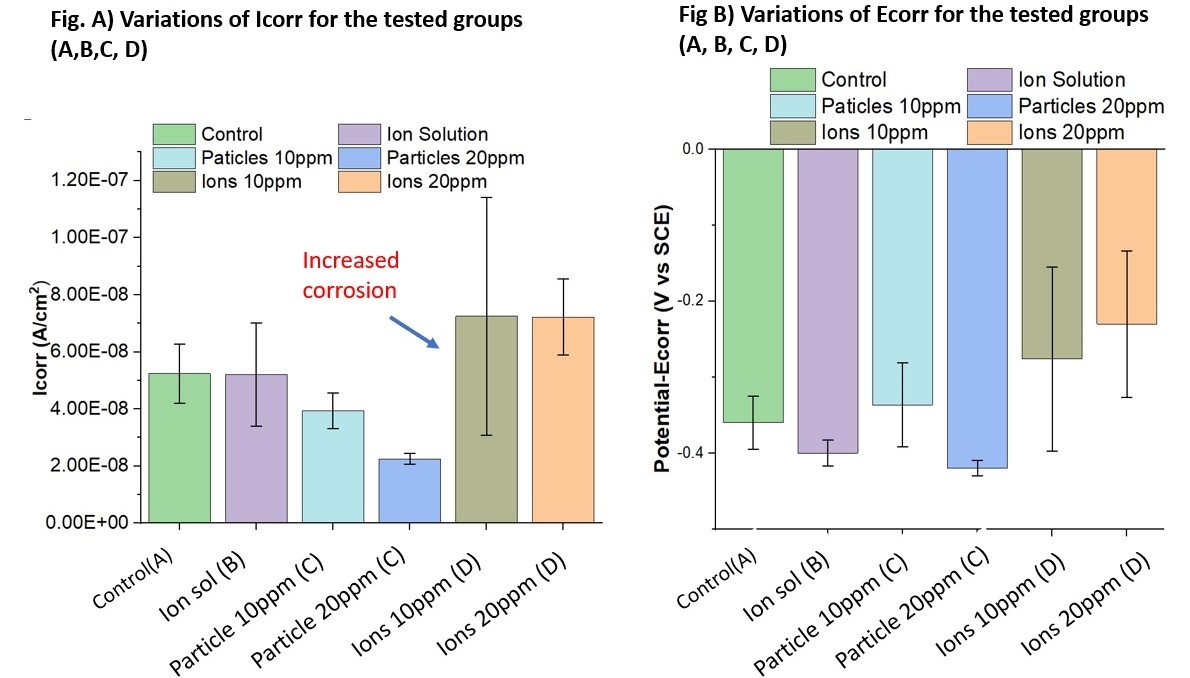IADR Abstract Archives
Ti-Ions and/or Particles in Saliva Potentially Aggravate Dental Implant Corrosion
Objectives: One of the potential risk factors for peri-implantitis is corrosive titanium (Ti) products in the peri-implant tissues. There is no much information available on the effect of the corrosion and wear products, i.e., Ti-particles and Ti-ions, on the corrosion processes of the implant. Therefore, we determined the influence of Ti-ions and Ti-particles on dental implant corrosion.
Methods: Eighteen commercially pure Ti grade 2 discs (11 x 7 mm) were polished to mirror-shine (roughness average= 50 nm). Samples were divided into four groups (n=3) as a function of electrolytes; A) Artificial saliva (AS), B) AS with Ti-ions (the electrolyte from group A, after the test), C) AS with Ti-particles-10 and 20 ppm D) AS with Ti-ions-10 and 20 ppm. Using Tafel’s method, corrosion potential (Ecorr) and current density (Icorr) were estimated from potentiodynamic curves. Electrochemical Impedance Spectrometry (EIS) data was used to construct Nyquist and Bode plots, and an equivalent electrical circuit was used to estimate polarization resistance (Rp) and double-layer capacitance (Cdl). The corroded surfaces were examined through a 3D white-light microscope and scanning electronic microscopy.
Results: The potentiodynamic curves demonstrated that in the saliva with Ti-ions (group B), there was a statistically significant increase in Ecorr compared to control (P=0.04). Additionally, in group D with Ti-ions, the Icorr increased (7.23 x 10-8 A/cm2) as compared to the control (5.24 x 10-8A/cm2), see Figures A&B. Conversely, in group C, when Ti-particles were present in the saliva, the Icorr marginally decreased compared to the control. However, there were no statistically significant differences in Icorr values among all groups (P>0.05). The EIS data also support the observations.
Conclusions: The study indicated that higher Ti-ions potentially aggravate corrosion. Under such a severe corrosion environment, there is a risk of increased tissue damage and peri-implantitis. The study will continue to investigate the concurrent effect of corrosion and peri-implantitis in dentistry.
Methods: Eighteen commercially pure Ti grade 2 discs (11 x 7 mm) were polished to mirror-shine (roughness average= 50 nm). Samples were divided into four groups (n=3) as a function of electrolytes; A) Artificial saliva (AS), B) AS with Ti-ions (the electrolyte from group A, after the test), C) AS with Ti-particles-10 and 20 ppm D) AS with Ti-ions-10 and 20 ppm. Using Tafel’s method, corrosion potential (Ecorr) and current density (Icorr) were estimated from potentiodynamic curves. Electrochemical Impedance Spectrometry (EIS) data was used to construct Nyquist and Bode plots, and an equivalent electrical circuit was used to estimate polarization resistance (Rp) and double-layer capacitance (Cdl). The corroded surfaces were examined through a 3D white-light microscope and scanning electronic microscopy.
Results: The potentiodynamic curves demonstrated that in the saliva with Ti-ions (group B), there was a statistically significant increase in Ecorr compared to control (P=0.04). Additionally, in group D with Ti-ions, the Icorr increased (7.23 x 10-8 A/cm2) as compared to the control (5.24 x 10-8A/cm2), see Figures A&B. Conversely, in group C, when Ti-particles were present in the saliva, the Icorr marginally decreased compared to the control. However, there were no statistically significant differences in Icorr values among all groups (P>0.05). The EIS data also support the observations.
Conclusions: The study indicated that higher Ti-ions potentially aggravate corrosion. Under such a severe corrosion environment, there is a risk of increased tissue damage and peri-implantitis. The study will continue to investigate the concurrent effect of corrosion and peri-implantitis in dentistry.

